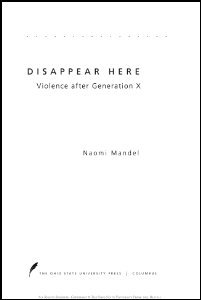By by Naomi Mandel.
Generation X, comprised of people born between 1960 and 1980, is a generation with no Great War or Depression to define it. Dismissed as apathetic slackers and detached losers, Xers have a striking disregard for the causes and isms that defined their Boomer parents. In Disappear Here: Violence after Generation X, Naomi Mandel argues that this characterization of Generation X can be traced back to changing experiences and representations of violence in the late twentieth century. Examining developments in media, philosophy, literature, and politics in the years Xers were coming of age, Mandel demonstrates that Generation X’s unique attitude toward violence was formed by developments in home media, personal computing, and reality TV. This attitude, Mandel contends, is key to understanding our current world of media ubiquity, online activism, simulated sensation, and jihad. With chapters addressing both fictional and filmic representations of violence, Mandel studies the work of Bret Easton Ellis, Chuck Palahniuk, Claire Messud, Jess Walter, and Jonathan Safran Foer. A critical and conceptual tour de force, Disappear Here sets forth a new, and necessary, approach to violence, the real, and real violence for the twenty-first century.
Columbus, OH: Ohio State University Press, 2015. 264p.







